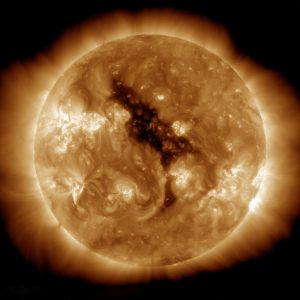Physicists and other scientists of all shapes and sizes have been trying for decades to achieve what the sun does all the time: fusion. This is the process of forcing elements together to produce “safe energy”. Needless to say they have not succeeded, at least not for more than a nanosecond. The forces required are currently beyond the capability of science. What they really need is a ball at least 300 000 times heavier than Earth.
Stars with a solar mass up to 1.5 go through a fusion process known as proton-proton chain reaction, and it goes through several stages:
- Two hydrogen protons collide to create a positron, a neutrino, an uncharged neutron, a proton, and gamma rays.
- The uncharged neutron and proton fuse to create deuterium (heavy hydrogen).
- When a third proton collides with this deuterium a helium-3 nucleus and a gamma ray is created.
- Two helium-3 nuclei collide to create a helium-4 nucleus and two excess protons. This process releases energy in the form of heat and more gamma rays, which eventually become sunlight.

Taken by Nasa on 3rd June 2012 this image shows a “Coronal Hole” – the dark gash across the middle of the sun. Coronal Holes are associated with ‘open’ magnetic field lines and are often found at the sun’s poles, and they generate high-speed solar winds. Image Credit: NASA/AIA
Particles of light and heat are called photons. They take a long journey through the inner layers of the sun before we see them as light. Indeed, the photons we see today began their journey long before we were born. Photons must first escape the radiative zone which is 375 000 kilometres thick and of very compact material. Enormous heat, density and interaction can keep a photon occupied trying to do this for anything up to 5 000 years—even longer. Then at a depth of about 183 000 kilometres beneath the surface of the sun the photons finally enter the convective zone, from which it takes just 10 days to reach the surface; and then eight minutes to reach Earth. This is the energy we see, and it accounts for only 1% of the total energy produced by the sun.
The fusion process also creates X-rays and gamma rays. Both are high energy photons. They have very short wavelengths and therefore very high frequencies. Like visible photons they have no mass and no electrical charge. X-rays are emitted by electrons outside the nucleus while gamma rays are emitted by the nucleus itself. X-rays contain between 100 to 1 000 times as much energy as visible photons, while gamma rays contain about 10 000 times as much energy.
Neutrinos are also produced by fusion, billions of them. In fact, something like 60 billion per cm2 per second. No kidding. They are neutral elementary particles and are everywhere. They are trillions of times smaller than the size of an atom. Indeed, they are so small they travel though anything, space, atoms, matter, people, without so much as a by your leave. Boffins reckon you get a dose of 100 trillion neutrinos a second! Not only that. We get even more from natural and artificial radioactivity. Even our bodies produce neutrinos, from our own potassium -40.
For stars above 1.5 solar masses the fusion process is somewhat different.
C-N-O Cycle
Above 1.5 solar masses and with core temperatures of more than 20 million °C the fusion process takes the shape of a carbon cycle whereby carbon, nitrogen and oxygen are used as catalysts. It is called the C-N-O cycle and is quite complex with the process going through several stages. It involves a fast-moving proton diving into a carbon nucleus and turning it into radioactive nitrogen. When a positron is ejected the seventh proton becomes a chargeless neutron, becoming carbon again, but with a nuclear mass of 13 not 12. A positron is a positive electron. When another proton dives into this mix it turns it into a normal nitrogen atom. In stage three another proton arrives, and a positron is shot out (as in stage one). This is now a radioactive oxygen nucleus. And again one of the protons turns into a neutron. Another proton arrives, turning the radioactive oxygen atom back into a normal oxygen atom. In the final stage a rearrangement of the nucleons takes place, and a helium atom is ejected, leaving the original carbon nucleus. The whole process is now repeated. A nucleon is either a proton or a neutron.
Looking at the periodic table one might wonder about lithium, beryllium and boron. After all, they are the third, fourth and fifth in terms of atomic number between hydrogen and carbon. The answer is that these elements are intermediate steps in other fusion reactions, and do not really feature. Essentially, after hydrogen is converted to helium-4, the chain reaction continues, converting the helium to heavier elements in multiples of helium-4; thus, predominantly carbon-12 and oxygen-16. Note that where helium sometimes fuses with hydrogen it may create atoms of lithium and beryllium, but these are unstable and quickly break down to smaller helium nuclei again.
Back to Top
By Nigel Benetton, science fiction author of Red Moon Burning and The Wild Sands of Rotar.
Last updated: Friday, 26th February 2021